After its opening stop in Washington, D.C., on June 8 highlighted by a neighborhood Eucharistic procession with the theme, “Walk with Jesus: To Jesus Through Mary,” participants in the National Eucharistic Pilgrimage continued that walk the next day in the nation’s capital by attending a closing Mass at the Basilica of the National Shrine of the Immaculate Conception celebrated by Washington Cardinal Wilton Gregory that included a Eucharistic procession winding through the basilica’s Great Upper Church led by Bishop Michael F. Burbidge of Arlington, Virginia.
Cardinal Gregory, the main celebrant at the National Eucharistic Pilgrimage Mass on June 9 at the Basilica of the National Shrine, in his homily said the Eucharist reflects God’s steadfast friendship and “journey of love” with His people.
“In this sacrament, God Himself comes close to each one who receives this gift. The Eucharist is God’s offering of His hand in a sacramental way in order to draw us close to Him,” the cardinal said. He added that in the Eucharist, “Jesus is truly present in such a magnificent way that he invites us to dine with and on Him. He offers us not merely food but eternal life in this sacrament.”
Noting that while some have distanced themselves from the Bread of Life, refusing to believe that it is truly the living Lord, or believing that it is just a “symbolic manifestation" or it “has lost its meaning or relevance or importance in our highly technologically sophisticated society,” the cardinal emphasized that in the Eucharist, God gives himself to people completely.
The National Eucharistic Pilgrimage, winding through four different parts of the country and culminating in the National Eucharistic Congress on July 17-21 in Indianapolis, is part of a three-year National Eucharistic Revival initiated by the U.S. bishops to inspire greater understanding of and love for Jesus in the Eucharist.
Cardinal Gregory in his homily underscored that point, saying, “We are engaged in a national spiritual journey project to strengthen our belief that the Eucharist is truly the most perfect gesture of God’s intense desire to be with us under the forms of bread and wine. Christ is truly present in such a manner that defies our ability to fully grasp the wonder of this gift.”
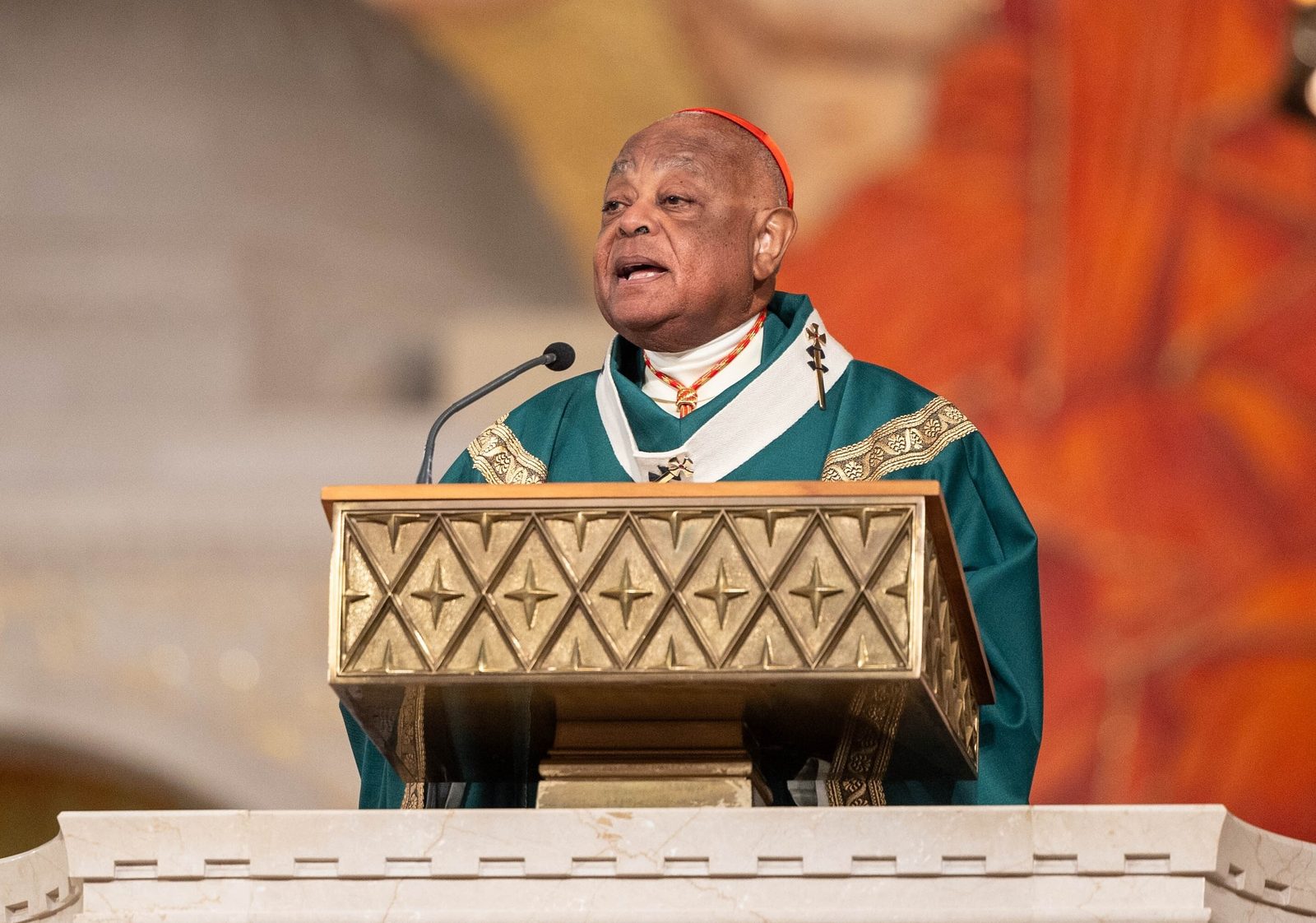
The eastern route of the National Eucharistic Pilgrimage, named for St. Elizabeth Ann Seton, the first American-born saint, began its stop in Washington D.C., on the previous day with an opening Mass at the National Shrine. Then 1,200 people joined a Eucharistic procession through the surrounding Brookland neighborhood that included stops at The Catholic University of America, the Dominican House of Studies and the headquarters of the U.S. Conference of Catholic Bishops, and concluded with Benediction at the Saint John Paul II National Shrine and a catechetical talk on the Eucharist led by Catholic young adults from the Washington area. Earlier in the week, the National Eucharistic Pilgrimage’s eastern route included Eucharistic processions at Emmitsburg, Maryland, and Baltimore.
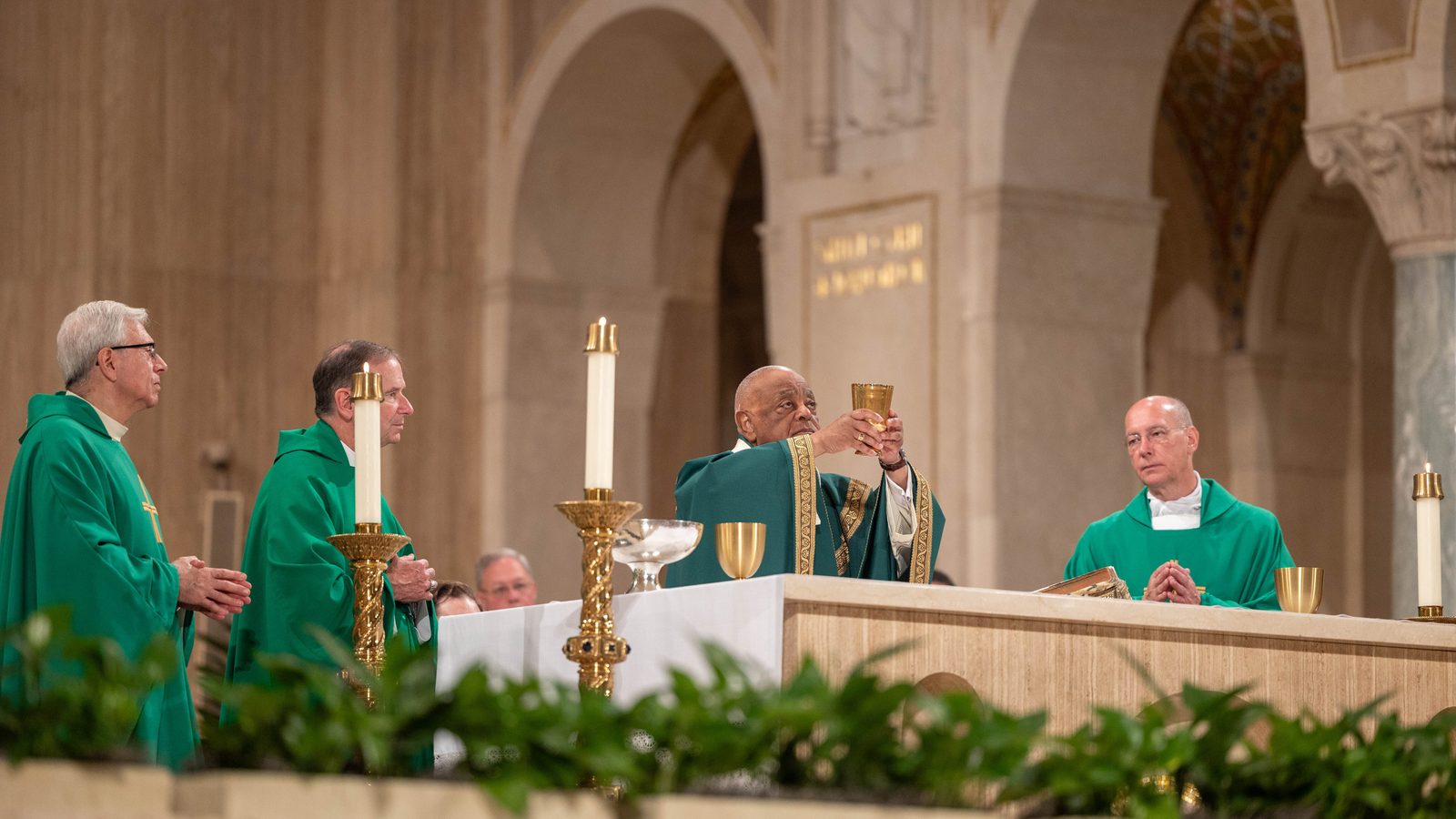
The thousands of people attending the June 9 closing Mass of the Washington leg of the National Eucharistic Pilgrimage at the Basilica of the National Shrine of the Immaculate Conception were welcomed by Msgr. Walter R. Rossi, the basilica’s rector, who said, “May Our Lady accompany our steps this afternoon, so that as we ‘Walk with Jesus: To Jesus Through Mary,’ Our Lady will lead us to a more perfect union with her Divine Son.”
The National Shrine, known popularly as “Mary’s House,” is the largest Catholic church in the United States, and it draws more than one million visitors and pilgrims each year from across the country and from around the world.

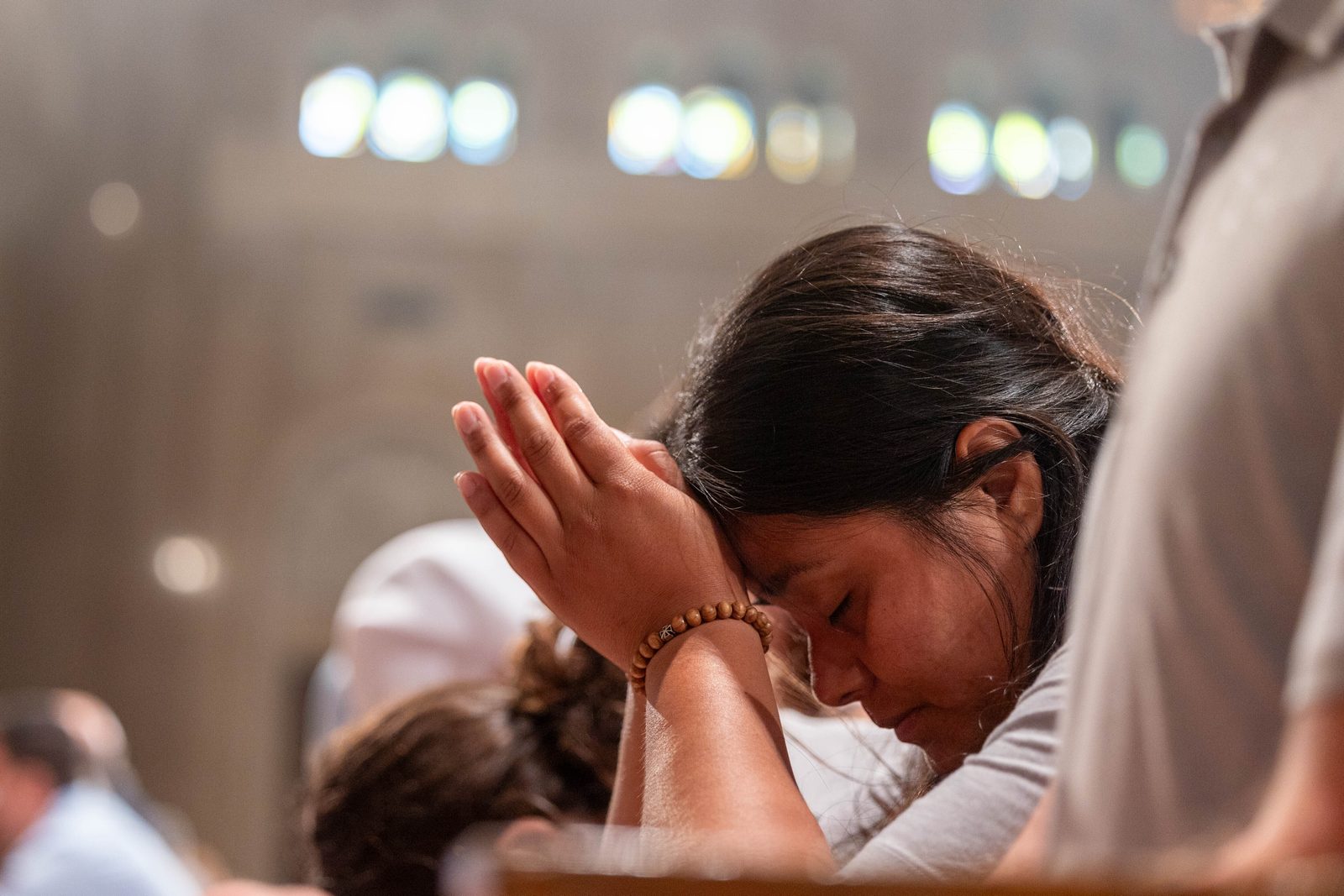
As the June 9 Mass opened at the National Shrine, Cardinal Gregory offered a special welcome to people from the Diocese of Arlington, which on the day before had celebrated the 50th anniversary of its 1974 founding with a Diocesan Golden Jubilee celebration at the Warren County Fairgrounds in Front Royal, Virginia. “May God bless you and bring you many more years of happiness and faith,” the cardinal said.
After Communion at the National Eucharistic Pilgrimage Mass, the Most Blessed Sacrament was placed in a monstrance, and the sacrament was incensed. Then the solemn Eucharistic Procession, led by Bishop Burbidge, proceeded throughout the nave of the Great Upper Church. When the procession returned to the main altar, the Blessed Sacrament was incensed as the Benediction hymn Tantum ergo was sung.
Bishop Burbidge then prayed, “O God, who in this wonderful sacrament have left us a memorial of your passion, grant us, we pray, so to revere the sacred mysteries of your Body and Blood, that we may always experience in ourselves the fruits of your redemption.”
Then the bishop and people prayed the Divine Praises together, which concluded with the words, “May the heart of Jesus, in the Most Blessed Sacrament, be praised, adored and loved with grateful affection at every moment in all the tabernacles of the world, even until the end of time.”
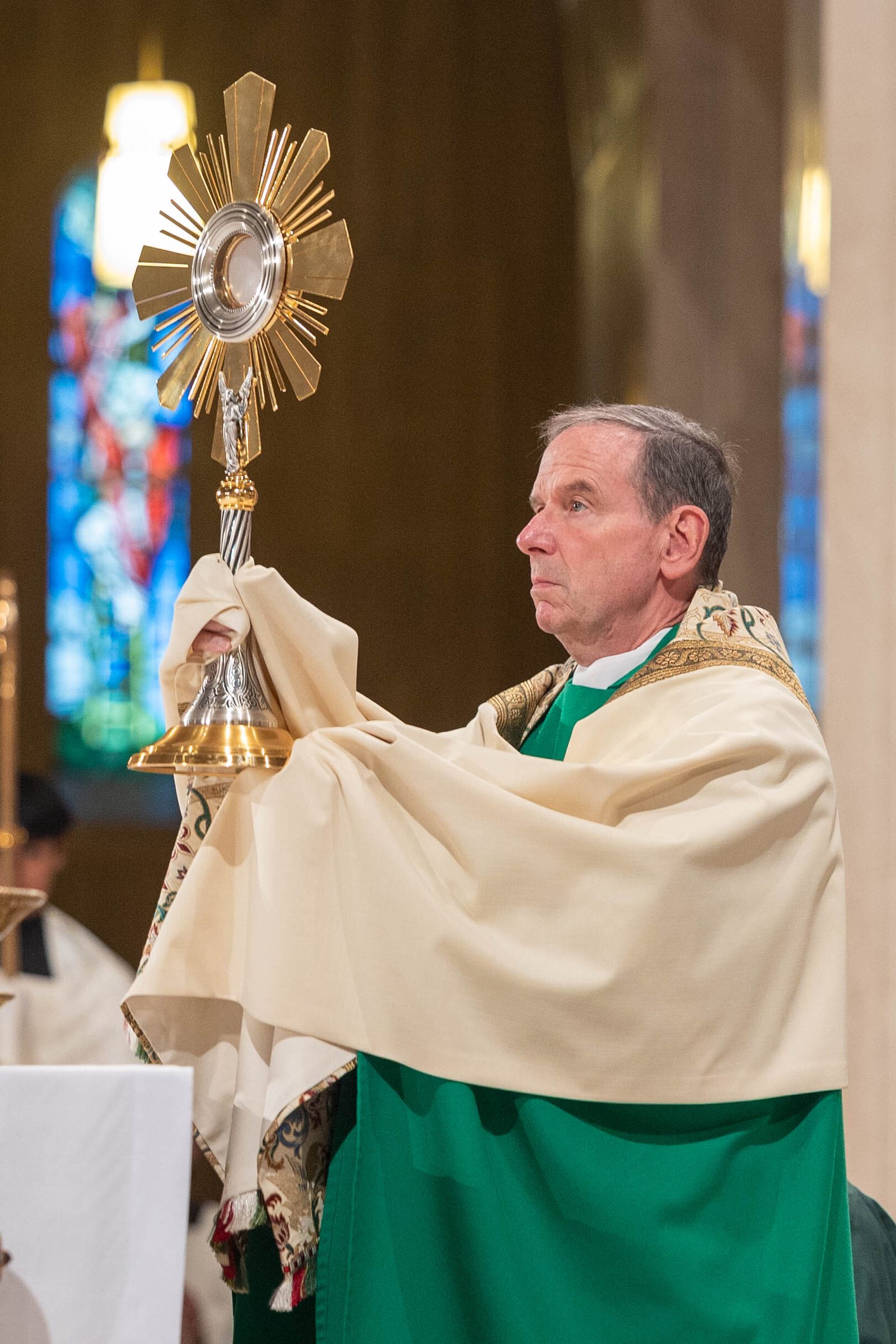

The Mass concluded with the singing of the hymn, “Holy God, we praise thy name.”
In an interview afterward, Bishop Burbidge said he hoped the National Eucharistic Revival, the pilgrimages underway and the upcoming National Eucharistic Congress would instill in people what Saint John Paul II referred to as “Eucharistic wonder and awe.”
“It’s so easy, like any gift, to take a gift for granted. This is the most precious gift of all that God has given to us,” Arlington’s bishop said, adding that he hopes “especially at this time in our nation, that we see the Holy Eucharist as that which unites us, unites us as the Body of Christ.”
Bishop Burbidge said the National Eucharistic Pilgrimage offers a reminder that “life here on Earth is a procession, it’s a journey, and we’re called to help each other get to the ultimate destination, heaven.”
He also expressed hope that the National Eucharistic Revival will be a time of prayer for “all those good people, who for one reason or another, have wandered away from the Lord or the Church, that this may be a sacred moment, where they see that God’s love and His Church, the arms are open to welcome them home and embrace them in love and mercy. The Lord stands ready to do that, the Church stands ready to do that, we as fellow parishioners stand ready to do that.”
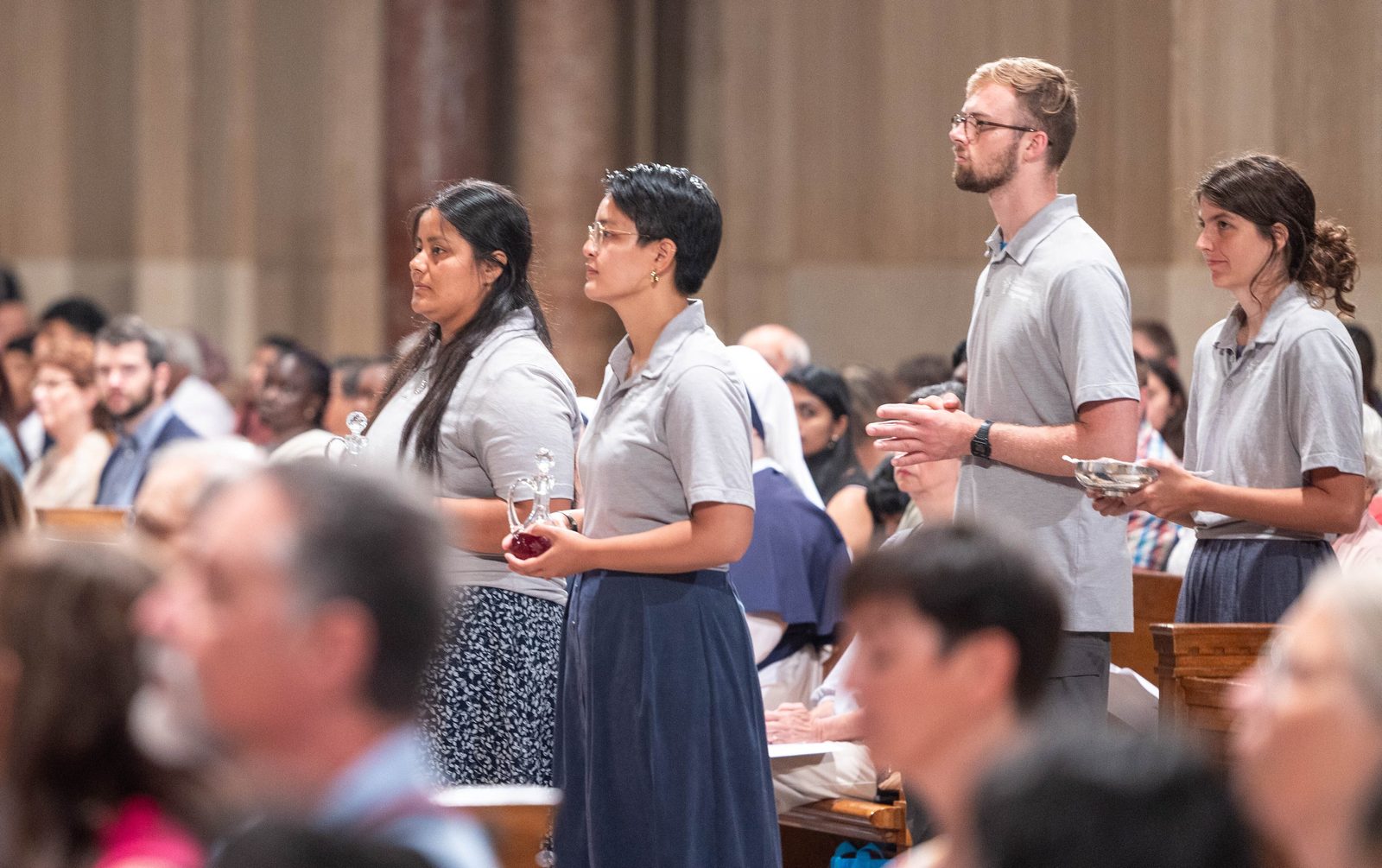
Earlier during the National Eucharistic Pilgrimage Mass at the basilica, the offertory gifts were brought to the altar by young adult Catholics serving as “perpetual pilgrims” who are accompanying the Blessed Sacrament on the pilgrimage’s St. Elizabeth Ann Seton Route in the Eastern United States.
After the Mass, two of those “perpetual pilgrims,” Zoe Dongas of Nashville who is now living in New York City, and Dominic Carstens of the Diocese of La Crosse, Wisconsin, reflected on that journey.
“I hope God transforms my heart and the country,” Zoe Dongas said. She added, “It’s just been such a gift to spend this intimate time with our Eucharistic Lord and to see how He has blessed this country and brought His people to Himself.”
Describing what the Eucharist means to him, Dominic Carstens said, “The Eucharist is the culmination of God’s love for me. It’s His way of chasing me down and being present with me. Two thousand years after He (Jesus) walked on the Sea of Galilee, we get to walk with Him today. He’s still present.”
Carstens said it was especially moving to be a part of the National Eucharistic Pilgrimage during its stop in Washington, D.C. “It’s a national movement to renew our entire nation, so to be in our nation’s capital is really momentous for us,” he said.

Among those attending the National Eucharistic Pilgrimage Mass at the Basilica of the National Shrine of the Immaculate Conception were Tony Rizzuto, his wife Alison, their daughter Charlotte who is 10, their son Leo who is 6, and their 1-year-old baby daughter Penelope. The Rizzuto family members, who are parishioners of St. Leo the Great Catholic Church in Fairfax, Virginia, had joined the Eucharistic procession the day before that wound from the basilica through the surrounding neighborhood to the Saint John Paul II National Shrine.
“Everybody walked. She (Penelope) was carried,” said Tony Rizzuto in an interview in the basilica’s lower level before the Mass, as he again held his baby daughter. His young son Leo, commenting on his procession experience, said, “I was tired!”
Tony Rizzuto, who works for the United States Space Force at the Pentagon, said their family plans to attend the National Eucharistic Congress in Indianapolis next month. “It (the Eucharist) is God’s presence in the world,” he said.
Both he and his wife said an especially moving thing that they witnessed during the Eucharistic procession the day before was when a man on the street asked a women participating in the procession what was going on, and she explained Catholic teaching on the Eucharist to him.
“It was neat to see people coming out on their balconies. It was undeniable that there was something beautiful passing by,” Alison Rizzuto said.
Her husband said it was moving to join that Eucharistic procession through the neighborhood near the National Shrine, and “to see the whole spectrum (of people alongside us), from men and women religious, to college age kids, to younger kids, to families, to older adults.” He added, “It makes you feel you’re not alone. Even though the culture is very different, a lot of people understand what a Eucharistic procession means and why it is important.”
Alison Rizzuto noted that their family had just visited Rome, and when she returned home, she missed the experience of being able to walk to a nearby church. But she said the Eucharistic procession offered a reminder that “we can walk with Jesus here where we are. It’s so important. There’s so much in our culture that’s loud.” The Eucharistic procession, she said, gave her children the opportunity to see “there’s beauty in silence and in the Eucharist.”
















